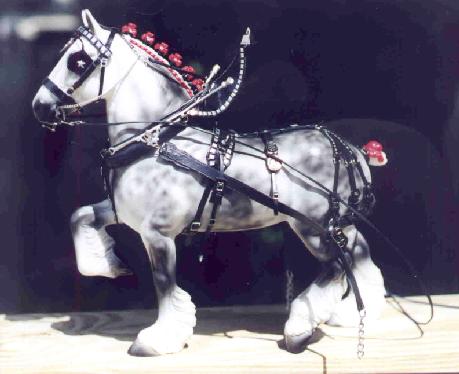

The pieces shown on this page were made by
those artists who have purchased the Guide and made tack according
to it, or who have been influenced and inspired by it. As
you can see, there are lots of possibilities out there!
Shown above is one of the earliest harnesses to be built
from the Guide: a fantastic draft show harness created by Darleen
Stoddard of NH in early 1999. She also took the picture.
Thank you Darleen! 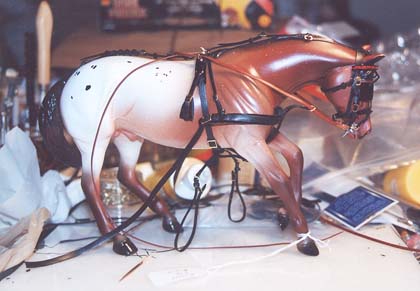
The record for first harness is surely held
by Stacey Rodriguez, who was in a position to be testing my
chapters even before the Guide was published. Her questions
were a great help in clarifying what needed explaining! She
made this Fine harness based on patterns in the Guide. I
believe it is the second harness she ever made.
Below and to the left is a Fine harness,
shown on the splendid Kathy Bogucki resincast saddlebred "Dozen
Roses", and built by Lorrie Franz, an accomplished tackmaker, and
seen at Greater Pittsburgh Model Horse Show in spring 2000.
This rig took second place out of a very competitive (Open)
class of 10. 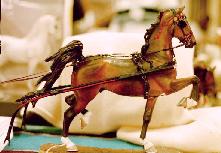 While
the Guide furnishes patterns and directions for a regular
breastcollar harness (in three levels of detail, so nearly
everyone can find something they're comfy with), these can easily
be adapted to other harnesses such as a Fine. Fine harness
is used in the arena to show off the high action of Arabs,
Saddlebreds and other refined breeds. Its most diagnostic
feature is the lack of breeching.
While
the Guide furnishes patterns and directions for a regular
breastcollar harness (in three levels of detail, so nearly
everyone can find something they're comfy with), these can easily
be adapted to other harnesses such as a Fine. Fine harness
is used in the arena to show off the high action of Arabs,
Saddlebreds and other refined breeds. Its most diagnostic
feature is the lack of breeching.
Here we have the terrific trio of a Draft
Unicorn hitch! This stunning set of harnesses was made by
Bobbi Devine from instructions in the Guide. 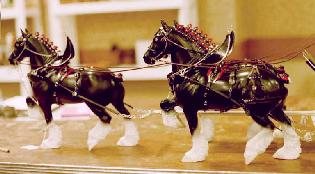 This is the get-up that won first place in the 2000 Greater
Pitt's Open Draft/Working Harness class. Click on the pic
for a close-up; you can almost hear the thunder of their hooves!
This hitch went on to take Misc. Perf. Reserve Champion.
Not bad for a first time out... Congratulations
Bonnie!! :) A Unicorn hitch is distinguished by having
a pair of horses as the wheelers and then one leader out in front.
The driver must have great confidence in his ability to
communicate to the leader; and that horse had better step lively!!
The photos at Greater Pitt were all taken by SBY.
This is the get-up that won first place in the 2000 Greater
Pitt's Open Draft/Working Harness class. Click on the pic
for a close-up; you can almost hear the thunder of their hooves!
This hitch went on to take Misc. Perf. Reserve Champion.
Not bad for a first time out... Congratulations
Bonnie!! :) A Unicorn hitch is distinguished by having
a pair of horses as the wheelers and then one leader out in front.
The driver must have great confidence in his ability to
communicate to the leader; and that horse had better step lively!!
The photos at Greater Pitt were all taken by SBY.
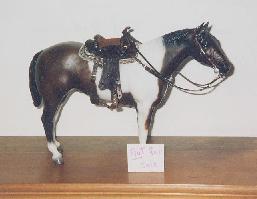
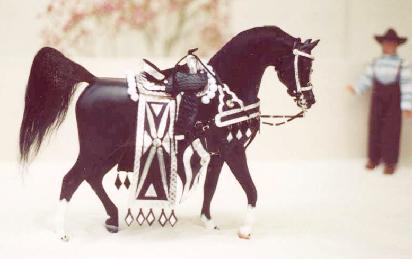 This stunning Parade saddle photo arrived in February 2001.
The horse is "Ev Jahfar" and he and his rig are owned by Susan
Hooton. The handsome saddle was made by Traci Durrell-Khalife.
To quote Susan: "She had your book and although she had never
made a parade set before she would be willing to try. The
result of her efforts---simply wonderful! I am still pinching
myself that I actually have a parade set now!" And what a nice
one---thank you. : ) You see, there is a great demand
for Parade sets by every level of collector; do not give up on
making one, or, barring that, finding someone to make one for you!
This stunning Parade saddle photo arrived in February 2001.
The horse is "Ev Jahfar" and he and his rig are owned by Susan
Hooton. The handsome saddle was made by Traci Durrell-Khalife.
To quote Susan: "She had your book and although she had never
made a parade set before she would be willing to try. The
result of her efforts---simply wonderful! I am still pinching
myself that I actually have a parade set now!" And what a nice
one---thank you. : ) You see, there is a great demand
for Parade sets by every level of collector; do not give up on
making one, or, barring that, finding someone to make one for you!
Here is another subject, the bosal hackamore. 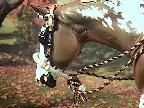 This
example was made by the talented Julia Harmon, who trains horses.
The bosal, braided from artificial sinew, was based on
instructions found in the Guide's Part 8, Chapter 39.
This
example was made by the talented Julia Harmon, who trains horses.
The bosal, braided from artificial sinew, was based on
instructions found in the Guide's Part 8, Chapter 39. 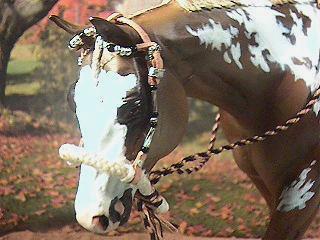 In
case help is needed with the spiral four-strand braid (seen here
for the mecate, the braided-hair reins of a hackamore) that too is
included. Julie made the headstall not from anything
specifically in the book, but from general knowledge of
tackmaking. However, the idea of using glass beads for real
silver beads is listed, as well as how to tie the mecate on.
:) These photos were taken by Julie. The horse
is the Black Horse Ranch Western Pleasure horse, repainted by
Amanda Ingram.
In
case help is needed with the spiral four-strand braid (seen here
for the mecate, the braided-hair reins of a hackamore) that too is
included. Julie made the headstall not from anything
specifically in the book, but from general knowledge of
tackmaking. However, the idea of using glass beads for real
silver beads is listed, as well as how to tie the mecate on.
:) These photos were taken by Julie. The horse
is the Black Horse Ranch Western Pleasure horse, repainted by
Amanda Ingram.
Despite this page being somewhat
harness-heavy, I can't resist putting in this unusual piece. 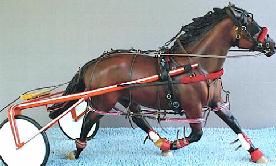 Never mind that the ankle boots etc. were made from Rio
Rondo kits---the author of the Guide is the privileged recipient
of some marvelous stories. I sold a copy to Peggy
Pritchard, a one-time harness race driver. Here it is in her
own words:
Never mind that the ankle boots etc. were made from Rio
Rondo kits---the author of the Guide is the privileged recipient
of some marvelous stories. I sold a copy to Peggy
Pritchard, a one-time harness race driver. Here it is in her
own words:
June 23: "I can't wait to start on the
harness's (sic)!"
July 6: "Well, here is my first attempt at
harness's (sic)! I did this one mostly from memory &
some pics in mags on harness racing. The hobbles were
ABSOLUTELY a terror to figure out! But I ended up red
braiding (sic) floss and threading it into airline tubing...
Other than that not too bad to put together. Your book
is a great incentive for creativity! My husband, (who builds
cl and rc airplanes) is building a modern sulky...for it too."
"I am just loving putting these together, its
(sic) almost like being at the track again." 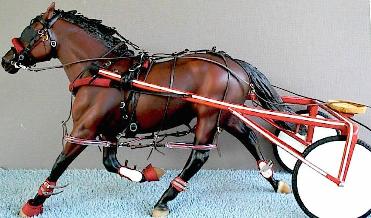 [Ed. note: the harness & sulky were sold on eBay.
The new owner took the outfit to BreyerFest.]
[Ed. note: the harness & sulky were sold on eBay.
The new owner took the outfit to BreyerFest.]
August 3: "Pacer harness and sulky went 3rd
in class of 15!!!! BreyerFest... We are so excited just cant
hardly stand it! Thanks so much for everything."
You're very welcome, Peggy! :)
These pictures were taken by Peggy and are used with her
permission. There isn't a pacer or trotter harness in the
Guide. But nonetheless, the book seems to be a good
inspiration... :)